Looking for an employee attendance tracker to manage your team?
Keeping track of employee attendance is vital for any business, large or small. However, without the right tools, this process can be a herculean task.
To help you out, this article covers the best ways to monitor your team’s attendance.
We’ll talk about the benefits of an employee attendance tracker, look at a sample attendance tracker template and explore the best attendance tracking software for your needs.
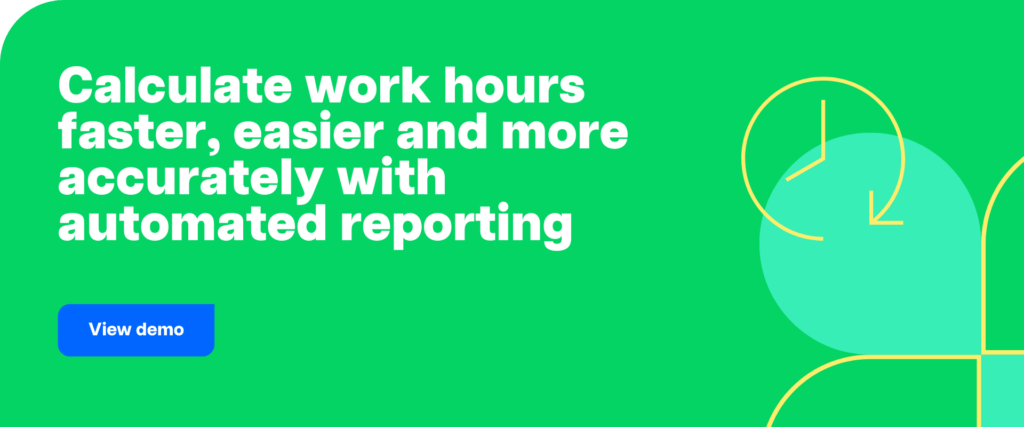
Table of Contents
- Why do you need an employee attendance tracker?
- Two common employee attendance tracker options
- The best employee attendance tracker in 2022: Time Doctor
Let’s get started.
Why do you need an employee attendance tracker?
Employee attendance trackers are pretty straightforward — they help you keep track of employee attendance.
But do you even need to track your employees’ attendance?
The short answer is yes.
Why?
There are several benefits to tracking employee attendance, regardless of what kind of business you run.
Here’s a closer look at 3 key benefits:
1. Keep track of attendance and absenteeism
You may be wondering, why do I need an attendance tracking system for this?
After all, you can see which employees work on any given day, especially in a smaller team.
However, it’s impossible for you to keep an accurate record of each individual’s attendance and absenteeism without tracking attendance.
An employee attendance tracker keeps a reliable record of attendance over several months and even years. You can access this anytime and anywhere to monitor your employees’ attendance — even from a mobile app on your iOS or Android mobile device.
Additionally, by tracking attendance, you can also take note of absenteeism. This lets you know if your employees could be slacking off or facing issues that impact their performance.
2. Plan and allocate vacations or time-off
With an employee attendance tracker, you can quickly check the sick leaves an employee has taken over the last month or so. This can help you assess whether they are actually eligible for requested vacation days or paid time off (PTO).
Additionally, by planning time-off allocation, you’ll always have enough members working at any given point.
This ensures that you don’t have too many employees taking leave at the same time, helping you run your business smoothly.
3. Check if employees are overworking themselves
While regular attendance is usually a good sign, you want to make sure that your employees aren’t overworking themselves!
It can easily lead to stress and burnout, impacting their health as well as overall productivity.
How do you avoid this?
When tracking employee leaves and absenteeism, keep an eye out for any employee who hasn’t taken a leave in a long time.
Encourage them to take some time off for themselves to help them maintain a healthy work-life balance.
Not only does this show your employees that you care for them, but it also helps you optimize your teams’ efficiency.
Now that you know why attendance tracking is essential for your business, let’s take a look at some of the options you have for tracking attendance:
Two common employee attendance tracker options
When it comes to tracking employee attendance, you have a wide range of options available. From physical registers to several kinds of attendance software, various choices fit different needs.
In this article, we’ll look at two of the most common options that can work for any team – from small businesses to large enterprises:
1. Using a spreadsheet
Spreadsheet-based attendance trackers are pretty straightforward. They feature a table where you can mark each employee’s attendance or absence, whether on a daily basis or a weekly summary.
Free spreadsheet template for employee attendance tracking
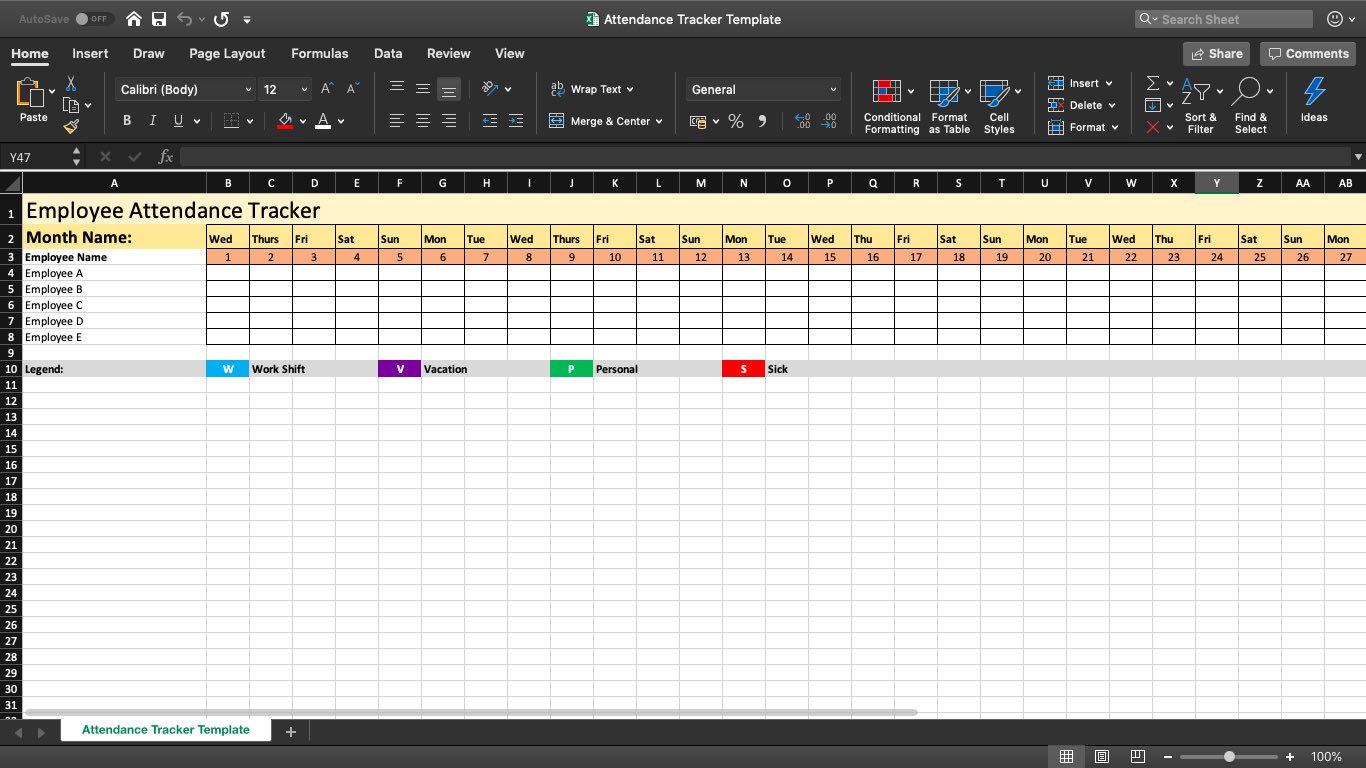
Click here to download this template.
Advantages
Here are the pros of using a spreadsheet to track employee attendance:
A. Easy to use
One of the most significant advantages of a spreadsheet-based attendance system over any other format is the ease of use. All it requires is a basic understanding of Microsoft Excel, Google Sheets or any preferred spreadsheet software.
With an easy setup and little to no learning curve, you can get started with an Excel-based attendance tracker almost instantly!
B. Accessibility
Another major advantage of a spreadsheet-based employee attendance tracker is the ease of access.
The minimal setup and training costs make it a great solution for smaller businesses with a limited budget. It can be scaled to fit mid-sized companies as well, with more complex calculations and operations to keep the system organized.
Additionally, it’s easy to access no matter where and when you need it. Just upload the file to cloud-based storage for real-time edits and updates.
Disadvantages
Here are the three key problems of using a spreadsheet-based attendance tracker:
A. Manual and tedious
A major disadvantage of spreadsheet-based attendance trackers is that the entire process is still manual.
While this is manageable with smaller teams, it can quickly become exhausting over a long period of time or when your team grows beyond the current strength.
How?
Over time, keeping track of records over several months or years can become complicated and time-consuming.
Additionally, you still need to make manual entries for every employee each day, which takes more time than it’s worth. This distracts business resources from core activities, cutting down your efficiency.
B. Can be easily edited or manipulated
Just like old-school attendance registers, excel spreadsheets still rely on manual entries. This makes them easy to edit or manipulate in the wrong hands.
How?
Your attendance system should ideally be uneditable or have the ability to keep track of any and all edits over time. Every change made should leave a trace, making it much harder for someone to manipulate or falsify records.
However, a spreadsheet doesn’t usually support such features, leaving your attendance records unsecured and subject to misuse. While you can restrict access with the sharing options, the entire file will still be available to anyone with the link.
C. Lacks advanced attendance tracking features
For the amount of effort taken to maintain a spreadsheet-based attendance sheet, the payoff is extremely low.
At the end of the day, your attendance tracking is still limited to spreadsheet calculations and operations.
This means that you miss out on advanced features like:
- Tracking worktime or work hours between when they clock in and clock out.
- Payroll management to efficiently pay employees.
- Powerful integrations with other software to streamline your workflow, and more.
So what’s the alternative?
Let’s take a look:
2. Using software
Dedicated attendance tracking software gives you powerful features at an affordable price with little to no learning curve. It’s easy to use, integrates with other tools and can automatically produce detailed reports for analysis.
Why software solutions are the best
Here’s an overview of the main advantages of a good attendance tracking software:
A. Offers more than just attendance tracking
While attendance tracking is important, it’s not enough.
After all, you only know whether your employees were at work or not.
It doesn’t tell you:
- The actual amount of employee time spent productively.
- What your employees worked on.
- How many hours you can bill each client for.
However, good attendance tracking software not only offers advanced attendance tracking features — but it also gives you additional information to help boost business productivity.
B. Helps you measure and boost productivity
The right attendance tracking software can tell you how long each employee spent on any task during the day. This lets you calculate productivity for each individual as well as the entire team.
How does this help you?
By measuring productivity, you can find potential barriers that are keeping your team from working at their optimal efficiency. This allows you to identify and eliminate, or at least reduce, such barriers to boost overall productivity.
C. Supports payroll management and integration
If you bill your clients or pay your employees by the hour, payroll management is an essential feature for your attendance tracker.
Why?
A spreadsheet is easily editable and can’t suffice as proof for the number of hours worked.
However, attendance tracking software with payroll management features can help you out with this. It allows you to easily track each hour spent on a particular client’s work and automatically generates an invoice for the same.
Some attendance tracking tools even support integrations to help you pay your employees without leaving the platform.
The best employee attendance tracker in 2022: Time Doctor
Today, there are dozens of employee attendance trackers available online.
What does this mean for you?
While this does increase the variety of choices you have, it makes it much harder for you to pick the right one.
To make this easier, let’s take a look at the best employee attendance tracking software you can use in 2022: Time Doctor.
What is Time Doctor?
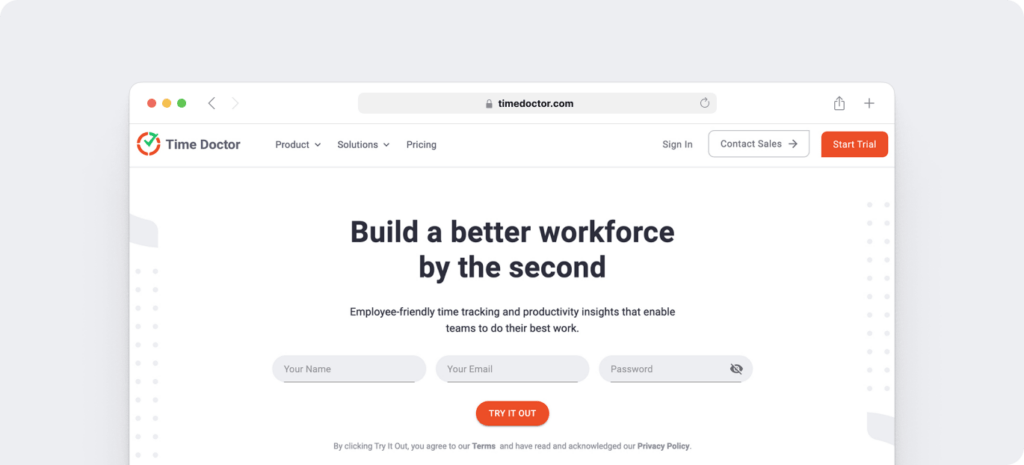
Time Doctor is an all-in-one employee attendance tracking and productivity management tool. It’s used by huge firms as well as smaller enterprises to manage employee attendance and boost productivity across the board.
Time Doctor helps you:
- Easily track employee attendance.
- Generate powerful reports to analyze attendance and productivity.
- Manage and generate invoices for each client separately.
- Track attendance as well as employees’ time spent on each task.
Its powerful features and easy scalability make Time Doctor the perfect employee attendance tracking solution for any kind of company.
Let’s explore some of the features that make Time Doctor a great employee attendance tracker for your needs:
1. Attendance report
Time Doctor’s Attendance Report gives you a detailed overview of employees who are absent or late on each day, as well as why.
How?
Each time they are absent or late, your employees can easily enter their Absent/Late Reasons by going to Reports > Attendance from their Time Doctor web dashboard. As a manager, you can quickly access, view and edit these notes for any of your team members.
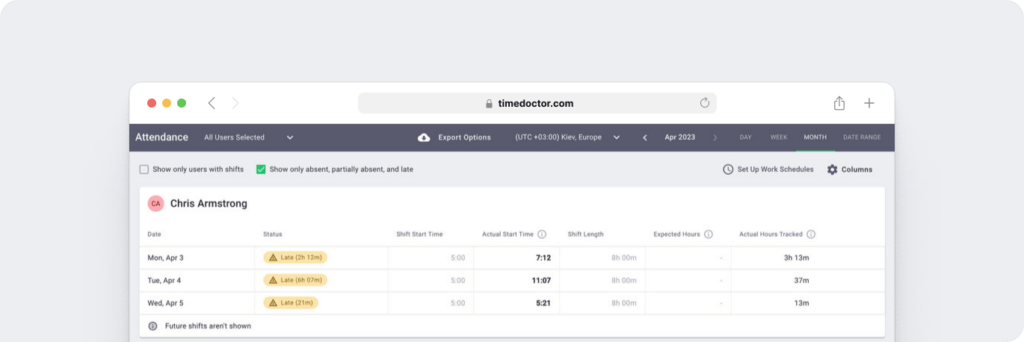
And that’s not all!
Time Doctor makes it easy for you to export the Attendance Report data in CSV or XLS format. You can customize multiple aspects of these reports, such as:
- Which users (employees) are included in the report.
- The date range or period of time to generate the report for.
- Adding or removing each line item by checking/unchecking it.
- Viewing the report before hitting export to edit it as and when needed.
2. Timesheet report
The Timesheet Report displays the amount of time worked by an individual or several employees during a specific day, week, month or custom date range.
Like the Attendance Report, you can customize several factors in the Timesheet Report.
These include:
- The users (employees) to include in the report.
- The report duration, as well as the beginning and end dates for this time range.
- The exact tracked time by going to the Edit Time page.
- The format for exporting the data, or whether you want to directly print the report without saving it.
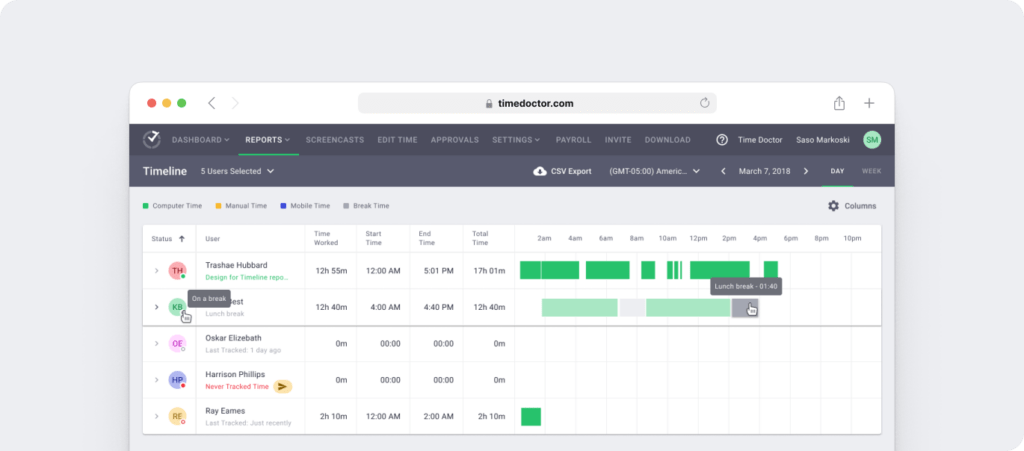
3. Payroll integration and management
The Payroll feature helps you calculate the payroll amounts for each employee as well as pay these easily. You can set up the Payroll according to your own preferences by customizing aspects like:
- The pay periods or cycle.
- Payment frequency.
- Pay rates, fixed or hourly.
- Payment methods.
- The currency for payment.
You can even customize these factors for each employee to manage payment accurately.
What’s more?
Time Doctor also integrates with several payment platforms such as PayPal, Payoneer and Wise, formerly TransferWise to help you pay your employees from within your employee attendance tracking system.
You can use any of the supported integrations, or even choose an alternative payment platform of your choice. Time Doctor makes paying your employees easy and efficient so that you can save time and energy for other business activities.
4. Simple time tracking
Without tracking exactly how long your employees are spending on productive work and on each task, you can’t measure or improve team productivity!
Luckily, Time Doctor can help you out with this as well.
Time Doctor features a simple and easy to use time tracker.
To start tracking time, all you need to do is install and open the Time Doctor app, enter your task name (and project, if applicable) and click on the Start button.
Time Doctor will instantly start the time clock that displays how much time you’ve spent on the task. Now, you can continue with your work as usual — Time Doctor runs silently in the background to maximize your focus.
To stop tracking productive time or take a break, just click on the Stop button.
It’s that easy!
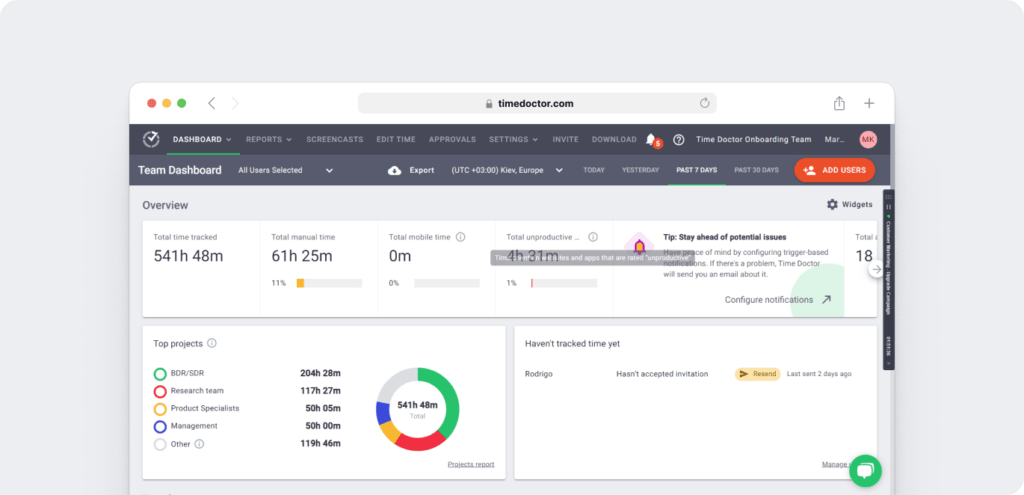
Final thoughts
An excellent employee attendance tracking system is essential for any business today. It helps you manage your workforce while making sure that you keep your operations running at an optimal level of productivity.
To truly take your business to the next level, you need a powerful employee attendance tracker like Time Doctor. This tool eliminates the inefficiencies of a spreadsheet system while giving you better and more accurate attendance records!
So why not sign up for Time Doctor to begin tracking your employee attendance today?

Liam Martin is a serial entrepreneur, co-founder of Time Doctor, Staff.com, and the Running Remote Conference, and author of the Wall Street Journal bestseller, “Running Remote.” He advocates for remote work and helps businesses optimize their remote teams.


